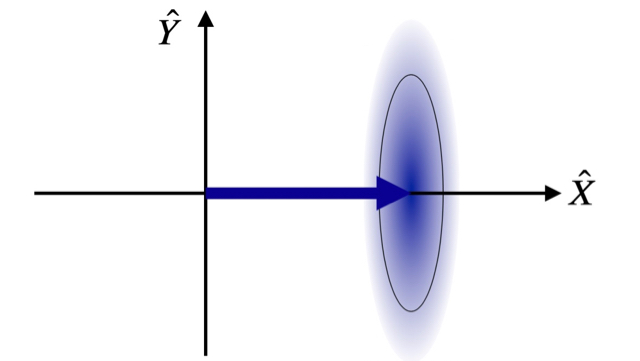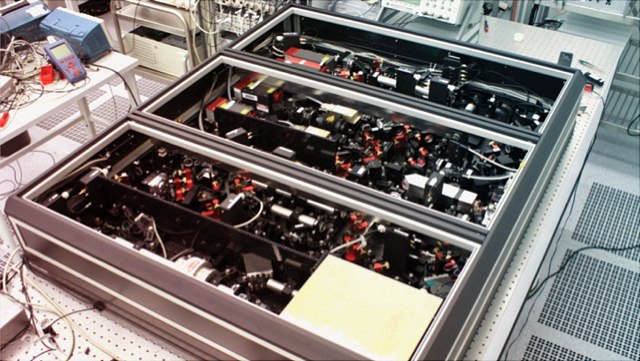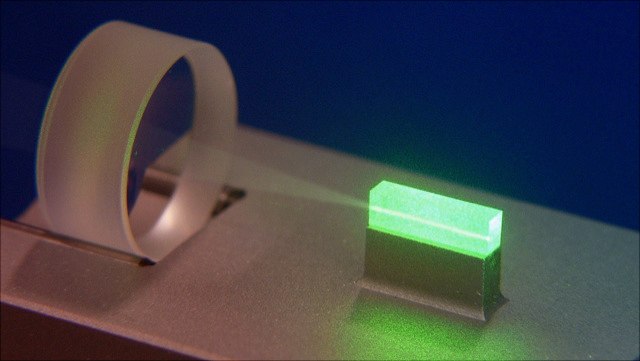Squeezed light
The word "squeezed" is a technical term in quantum physics. A beam of squeezed light has a lower quantum uncertainty than a beam without photons, at least for some phases of the electromagnetic oscillation. Squeezed light is therefore highly remarkable! It has quantum correlations that enable greater measurement accuracy and secure communication. After around 50 years of
research at various institutions around the world, Noisy Labs GmbH is the first company to offer squeezed lasers commercially. It is a spin-off of the University of University of Hamburg.

In terms of light, squeezed states show a squeezed uncertainty of electric field strength. Like any quantized oscillator, the field strength oscillation is described by two non-commutating quantities, here the amplitude quadrature amplitude (X) and the phase quadrature amplitude (Y). From the Heisenberg uncertainty principle follows in general: when X is squeezed, Y must be "anti-squeezed" at least as strongly. The picture on the left shows the quasi-probability distribution of a squeezed state shifted from the origin. The dashed circle indicates the ground state uncertainty in comparison [1].

Squeezed light is already used in a first useful application. Since 2010, the German-British gravitational-wave detector GEO600 has been using a squeeze-light source built by our group. Since then, the sensitivity of GEO600 has been better than ever. With gravitational-wave detection, non-classical light has a true application in metrology. (When using nonclassical states in metrology, the term "quantum metrology" is often used.) The figure shows the "GEO 600 squeeze source" [2], which is running around the clock. In order to be able to regulate all degrees of freedom in a stable manner, a foot print of 1.5 m2 was necessary. Early 2019, also Advanced LIGO and Advanced Virgo were equipped with squeezed light sources (squeezed laser) [3,4].
In the future, another real application could be optical communication (then: "quantum communication"). In 2015, our group implemented a new quantum key distribution (QKD) concept using squeezed light. QKD is the basis of quantum cryptography. For the first time, the absolute security was independent of potential operating errors or device failures at the receiver site [5].

Since 2008, the group has been producing the world's highest squeeze factors and is conducting squeezing experiments at 532nm, 1064nm, 1550nm and 2128 nm [6-8]. The figure on the left shows the optical components of a squeezing resonator consisting of a coupling mirror and a coated nonlinear crystal. If the crystal is pumped with light of e.g. wavelength 532nm, squeezed states occur at 1064nm via parametric conversion. In the next few years, squeezed light research will remain highly topical. New applications require new wavelengths as well as simplification and scaling down of the squeezing process. And still, in quantum optics, quantum metrology and quantum information, new concepts are proposed every year that can only be tested with squeezed light.
[1] R. Schnabel, Squeezed states of light and their applications in laser interferometers, Physics Reports 684, 1–51 (2017).
[2] H. Vahlbruch, A. Khalaidovski, N. Lastzka, C. Gräf, K. Danzmann, R. Schnabel, The GEO600 squeezed light source, Class. Quantum Grav. 27, 084027 (2010).
[3] M. Tse et al., Quantum-Enhanced Advanced LIGO Detectors in the Era of Gravitational-Wave Astronomy, Phys. Rev. Lett. 123, 231107 (2019).
[4] R. Schnabel and A. Schönbeck, The "Squeeze Laser”, IEEE Transactions on Quantum Engineering: Quantum Sensing and Metrology 3, 3500209 (2022).
[5] T. Gehring, V. Händchen, J. Duhme, F. Furrer, T. Franz, C. Pacher, R. F. Werner, R. Schnabel, Implementation of continuous-variable quantum key distribution with composable and one-sided-device-independent security against coherent attacks, Nature Communications 6, 8795 (2015).
[6] H. Vahlbruch, M. Mehmet, K. Danzmann, R Schnabel, Detection of 15dB squeezed states of light and their application for the absolute calibration of photo-electric quantum efficiency, Phys. Rev. Lett. 117, 110801 (2016).
[7] A. Schönbeck, F. Thies, R. Schnabel, 13dB Squeezed Vacuum States at 1550nm from 12mW external pump power at 775nm, Opt. Lett. 43, 110–113 (2018).
[8] C. Darsow-Fromm, J. Gurs, R. Schnabel, S. Steinlechner, Squeezed light at 2128 nm for future gravitational-wave observatories, Opt. Lett. 46, 5850 (2021).
